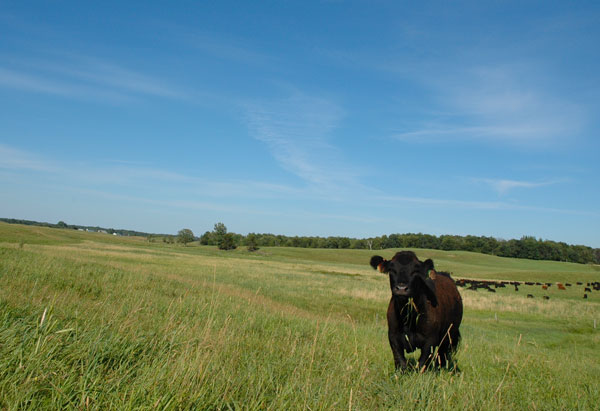
As a college sophomore pursuing a degree in agricultural education, I was encouraged by my academic advisor to attend the recent “Big Ag Business” communications and journalism workshop in Minneapolis. I decided to attend with the hope of gaining some useful information that would allow me to further develop my skills as an agricultural advocate.
After a round of introductions, my friend and I, both raised on farms, realized we were the only students in attendance amongst a full room of professional journalists. The workshop began with a session titled “An Overview of Reporting on Agribusiness,” during which speakers suggested websites for finding expert opinions and studies regarding practical agricultural concerns that they felt would help capture public attention and make for successful stories. However, the session left me a little apprehensive, as many of the sources seemed biased against agriculture.
In the next session, “Covering Agribusiness and Food Safety,” I became even more concerned by the remarks of an investigative reporter from Kansas.
Here are some of the points he made, and how I responded during the event:
1) “Ag-gag laws are made to prevent journalists to take an aggressive look at agriculture.”
Some state legislatures have passed what are termed “ag-gag” laws. These laws are aimed at protecting the privacy of farms by prohibiting surreptitious filming by animal activist groups. The reporter told conference attendees that People for the Ethical Treatment of Animals (PETA) had contacted him with undercover images of a farm abuse scene, but claimed that ag-gag laws prevented use of the pictures.
I told him that what he was given appeared to be Photoshopped images. “The Humane Society of the United States (HSUS) and PETA alter lighting and angles to make normal farm scenes look terrorizing,” I responded. I assured him that we, as farmers, care deeply for the comfort, health, and overall well-being of our animals. Yes, there are bad apples on every tree, but the majority do it right.
2) “Have you ever toured a beef feedlot? Have you ever been allowed to see what goes on behind the scenes in the beef industry? Ag doesn’t want us to know the truth.”
I confidently responded that my best friend lives on a beef feedlot. She and her family walk the cattle regularly, looking for any sick cattle, which are only administered FDA-approved antibiotics on an individual basis as needed. I pointed out that perhaps a broader perspective was in order. After all, according to the report, “Antibiotic Resistance Threats in the United States,” published by Centers for Disease Control and Prevention (CDC), “50% of all the antibiotics prescribed for people are not needed or are not optimally effective.”
3) “Food re-salvaging happens in all processing plants. All the fat, excess trimmings, and workers’ gloves, hair, etc. falls below onto a conveyor belt where it is ground up into stuff like pink slime. This contaminated food is packaged for resale.”
Food is not purposely contaminated, nor sold. Consumers hear of more food recalls today simply because the advanced technology exists to more minutely identify it. So-called “pink slime,” or lean, finely texturized beef, is made via a USDA-approved process and billions of pounds have been produced and safely consumed over the past several decades.
4) “Even cattle with cancer and abscesses are still packaged for meat, but chlorine and ammonia is poured over it to disinfect it. The USDA is cutting over 600 employees, so food inspection standards are going to get worse. Just because something is stamped with the label 'Passed and Inspected by USDA,' does not mean it is safe, or that it has been inspected at all.”
Any abscesses or imperfections are cut out of the meat before it is packaged for retail. USDA inspection guidelines are followed strictly and technology allows inspectors to prevent over 5,000 potential food-borne illnesses each year (USDA Food Safety Inspection Services).
5) “I have no doubt that family farms like yours are doing it right, but large operations are bad.”
Farms are not factories. Christensen Farms in Minnesota, for instance, is among the five largest pork producers in the U.S. and is completely family-owned. Biosecurity and ethical treatment are practiced no matter what level or size of farm.
Subscribe now to Cow-Calf Weekly to get the latest industry research and information in your inbox every Friday!
Needless to say, many of this speaker’s remarks upset me. Yet, I am grateful that my friend and I attended this event. Without our counterpoints to the speaker’s false accusations, only a biased perspective would have been offered.
When the speaker asked for questions, my friend and I raised our hands and took the opportunity to teach. We said we were both very disappointed in the negative picture presented about agriculture. We pointed out that an earlier presenter had stressed that “successful reporters are those who actually go out to the source.” I expressed my disappointment that he, the Kansas speaker, had not personally talked to farmers when covering his stories.
As we left the meeting, my friend and I reflected on what we thought would have been a highly useful and educational event. I decided that I did in fact walk out of the workshop as a more effective agricultural advocate, it just did not happen the way that I was expecting it to.
You Might Also Like:
Why The Cattle Market Is At A Critical Juncture
70 Photos Honor The Hardworking Cowboys On The Ranch
Cost Of Developing 2014 Heifer Calves Will Be Record High
What Are Corn Stalk Bales Worth?
Meet American Farmers: 80 Fun Farmer Photos
We Were Played: USDA Moves To Take Over The Checkoff
4 Ways To Better Manage Your Employee Relationships
Where Will Land Prices Be In 2015? We Have Answers
Why Freeze Branding Is ID Of Choice For Many Commercial Ranches
About the Author(s)
You May Also Like



